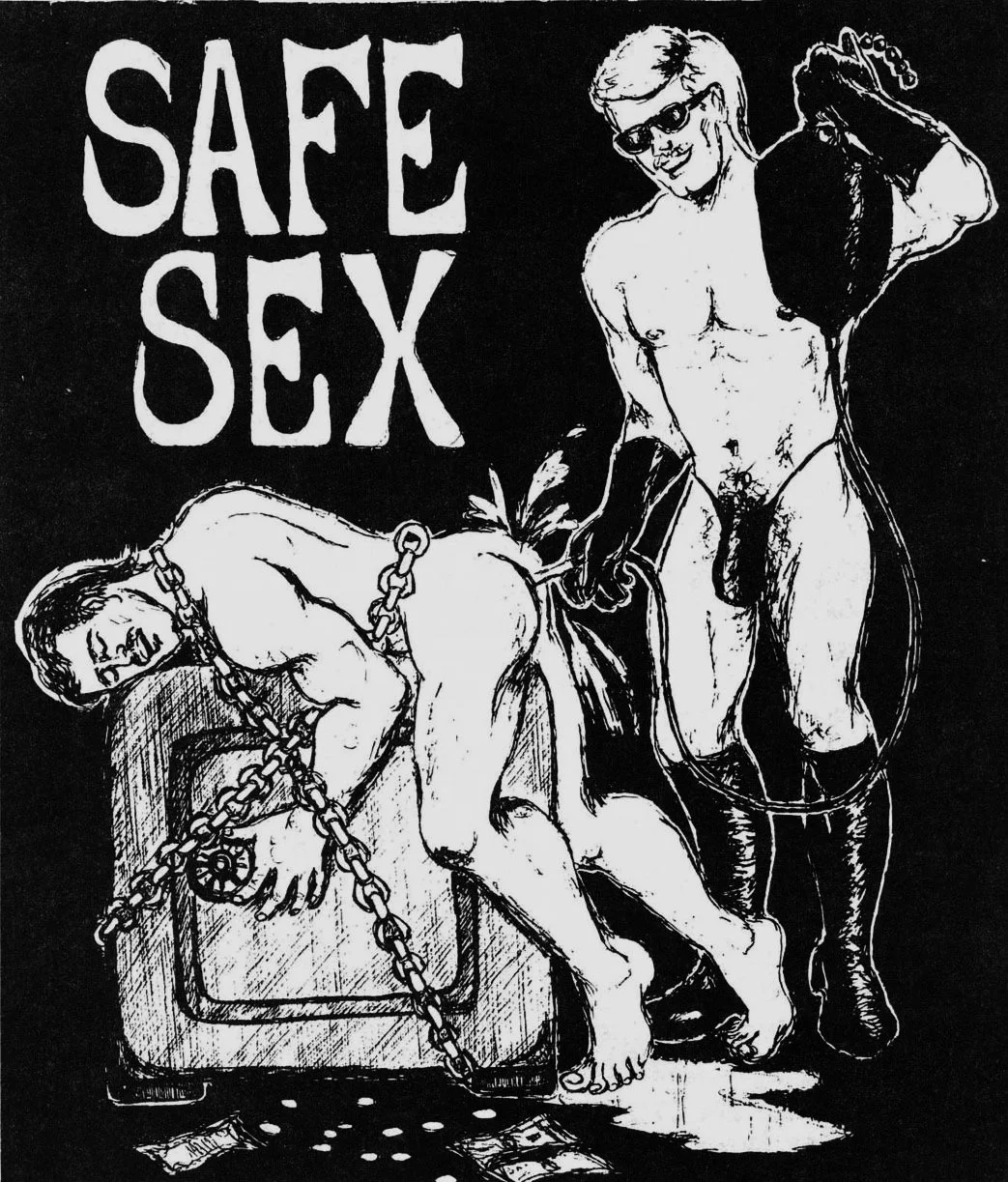
GOD IS THE GIVER OF THE GIFT
-
GOD IS THE GIVER OF THE GIFT -
Mark Bell
BY
Mark Bell BY
In 2003, not yet a decade after the height of the AIDS epidemic, Rolling Stone published an article titled “Bug Chasers: The men who long to be HIV+,” about an allegedly large proportion of gay men. “Bugchasers” were defined as a fetish subculture of gay men who wanted to become infected with, or to infect others, with human immunodeficiency virus. Citing anecdotal evidence (an interviewed man called “Carlos”) and statistics later proven wrong—at one point, stating that twenty-five percent of new HIV infections came from bugchasers (Freeman)—the article by Rolling Stone was the first exposure a general audience would have to the idea of bugchasing. In subsequent reports many of the claims made in the piece were debunked as obvious sensationalism. The physicians interviewed, upon being contacted by other journalists, denied the fact that they ever said any of the things they were quoted as saying in the article (Mnookin). Of course, none of this actually mattered, because the damage was already done. Bugchasing would remain in the mainstream public consciousness as a punchline, as the perceived epitome of sexual degeneracy, as a concept exploited for shock value. A symbol of the perverse, malicious, self-destructive nature of gay men.
The sensationalism attached to bugchasing is how I learned about it in the first place. It was the concept at the center of a harsh noise record by an artist called Straight Panic, named “God is the Giver of the Gift.” Bugchasing is a particularly abstracted, niche type of sexual intercourse that could only gain traction due to HIV prevention medication becoming available.
When it comes to fetishes, one of the first questions people ask is what actually causes someone to be sexually aroused by something that isn’t the norm. However, this question assumes that there is a default to sexual preferences, which is an assumption that runs counter to the view expressed by some authors analyzing bugchasing. The fact is simply that sex untouched by fantasy does not exist. Tim Dean mentions Freud when he writes about fetish, paraphrasing Freud’s ideas within the context of bugchasing and bareback (condomless) sexual practices:
Freud's value lies in his insistence that all sexuality, even its most routine and vanilla expressions, involves nonrational logics that may be bracketed under the rubric of the unconscious. On those odd occasions when sex is undertaken primarily for reproductive purposes, still it isn't exempt from fantasies…Freud revealed gender and sexuality as particularly dense sites for the elaboration of fantasy; gender and sexuality provoke our most wildly counterintuitive stories about ourselves. With respect to the pernicious hierarchy of normal and perverse, Freud leveled the playing field by showing how nobody has a fuck free from the baroque complications of fantasy, whether they’re aware of it or not. (Dean 83-84)
Upon reading this, the concept of a “fetish” itself seems to be a social construct. Bugchasing, then, doesn’t necessarily arise from a particularly unique desire to harm oneself or from maliciousness, but from a set of variables introduced by personal and cultural history.
People with fetishes this novel tend to share certain characteristics with each other. After the advent of the internet, gay cruising spots—with their historical importance as closed spaces in which niche sexual practices flourished among anonymous men—were replaced with their online equivalent: forums, social media, and hookup apps. Jaime García-Iglesias, writing for Deviant Behavior, interviewed three men who identify as “bugchasers,” named Scott, Marvin and Milo. He stated that the purpose of the interviews is to find “empirical, ethnographic and qualitative data about bugchasing experience” (García-Iglesias 1).
The responses of those interviewed indicate that the fantasy of bugchasing requires a degree of dissociation from the reality of HIV. The internet, convenience aside, appears to supply a buffer between fantasy and reality, providing a place where desire may remain abstract, as far away from causing harm as possible. The interviewees, speaking about what in particular arouses them about bugchasing, don’t mention the salient points that the general public associates with HIV: nobody’s bedridden, nobody has Kaposi’s sarcoma lesions, the disease dubbed “gay cancer” by the New York Times at the beginning of the burgeoning AIDS epidemic (Altman). The interviewees take the basic idea of HIV transmission, discard the chaff, and keep the ritualized power dynamic inherent to essentially allowing someone else control over the course of your life. “I want to feel that man… I want to have a part of another man living inside of me,” Scott explains (García-Iglesias 6). Milo, echoing a similar sentiment in different words, describes the bugchasing dynamic as vampiric: “I would expect my relationship with my gift-giver to be ritualized, maybe like the vampire and recruit relationship, if I may say so” (10).
Bareback sex is an uncommon sexual practice among gay men. Those seeking HIV-positive partners make up an exponentially smaller subcommunity of men among those who bareback, comprising a (very, very) vocal (very, very) few who primarily communicate online (Christian and Parsons 491). As a sort of small fetish “enclave,” it has been noted that bugchasers have created their own set of vocabulary to reinforce the power dynamics they desire, further abstracting conventional sexual intercourse into something specialized, something “hotter” (García-Iglesias 5)
more raw, more transgressive. Sexual thrill often seems to come from transgression, and the transgression of gay sex itself is arousing to some, Tim Dean writes, in a way that requires bareback and ultimately bugchasing to keep the thrill going: “If part of the appeal of gay sex consists in its transgressiveness (whether perceived or actual), then barebacking could be considered a strategy for reinscribing eroticism within the sphere of transgression,” (Dean 81).
The transgression is elevated by vocabulary unique to the bugchasing community. Those who infect others are called “giftgivers,” HIV being “the gift.” Semen that contains the virus is “poz,” shortened to “pozcum” (85). Dean writes more about the ritualistic concepts attached to bareback sex by the bugchasing community:
Much bareback discourse uses metaphors of insemination, pregnancy and paternity. "Let's breed" is one of the refrains heard regularly on barebacking websites, though I've encountered it only once in a sexual context that was not marked explicitly as a subcultural venue. Men who used not to worry about condoms because there was no fear of pregnancy in gay sex now understand their abandonment of condoms as an attempt to conceive… In breeding a virus, these men are propagating also a way of sexual culture with its own institutions, codes of communication, ethical norms, representational practices, and kinship arrangements. (86)
This is what is most intriguing anthropologically about bugchasing: the creation of what is seemingly a separate, parallel, abstracted system of sexual interaction out of something that, decades ago, was the living nightmare of gay men. This is not out of delusion. It is consciously done. It is important to note that bugchasers, by and large, are keenly aware of the transmission and symptoms of HIV. Marvin, interviewed by García-Iglesias, acknowledges the reality of HIV as someone whose life has been altered by it: “I lost most of my friends, lost most of my close friends, lost a lot, almost all of my past boyfriends, only one of them is still alive; and I lost the one person I truly loved… I lost all my friends and there is a big hole in my life as a result of that,” (García-Iglesias 7).
Bugchasing is a fetish that could only proliferate after HIV ceased to be a mortal threat to gay men in developed countries. Condoms and more recent developments in medicine such as Truvada, an AIDS drug for pre-exposure prophylaxis (shortened to PrEP), create a safety net which in turn creates a barrier, a taboo, to break. Unprotected sex—with the possible transmission of HIV—is consciously made to represent unmediated intimacy. Dean states that the desire for unmediated intimacy is so potent for some that it overrides any fear of the actual disease:
The idea of sex as raw, unmediated contact with another body or being is nothing more than a fantasy—albeit a powerful one—that responds to the intensively mediated conditions of modern existence. If our erotic lives were not so filtered through technology, pornography, pharmacology, and other forms of expertise, then perhaps the yearning for unmediated intimacy would not be so strong. (Dean 224)
Treatments for HIV/AIDS, having vastly, notably improved since the AIDS epidemic of the 80s and 90s, are the line of defense which allow the desire for unprotected sex to exist without the weight of death for gay men. They are the very thing that seems to justify the existence of bugchasing. Truvada, approved by the FDA in 2012, has become similar to the contraceptive pill for heterosexuals. “Officially licensed as a prophylactic,” Dean writes, “Truvada seems also to license enjoyment without limits” (228).
The internet, the medication, the sensationalist reporting on a demographic that is now de jure allowed to exist but still exists squarely outside of the social norm—the history of the post-antiretroviral generation is written in the existence of this fetish. Bugchasing presents an intriguing case study as an alternative mode of sexuality that seemingly may only exist at this point in history.


